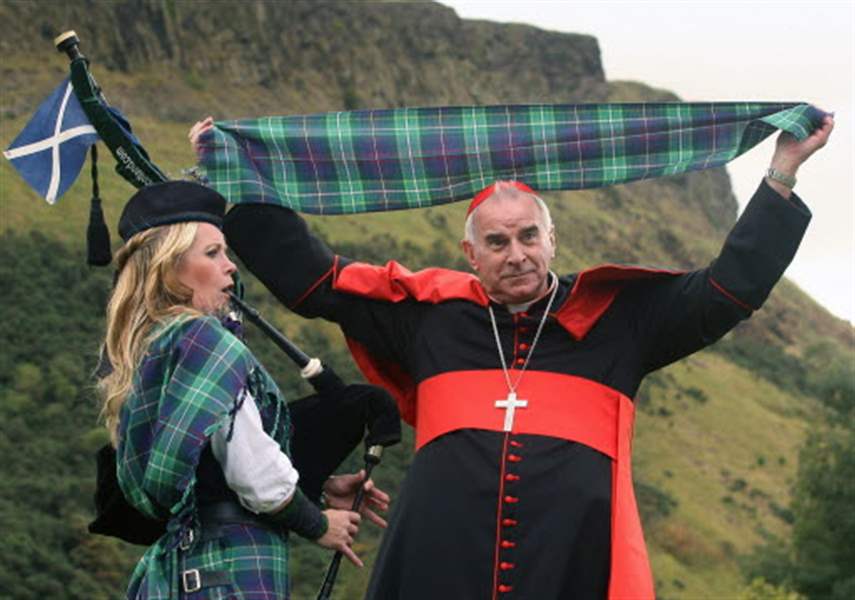
Mad for plaid: Michigan is the latest state to adopt official 'tartan'
12/19/2010
Cardinal Keith O'Brien unveils the first Papal visit plaid.
The 69-year-old weaver who designed Michigan's first official Scottish tartan fabric doesn't hem and haw when asked about men who wear kilts.
"It is beautiful," enthused Kati Meek, of Alpena, Mich. "I see something that is the sexiest garment a man can wear no matter what age or shape he is in."
Across the pond, wearers of the traditional garment are focused on the propriety of "going commando" (wearing neither boxers nor briefs underneath) and the failure of Prince William to adopt his father's practice of slipping into a kilt when at the royal family's Balmoral Castle in Scotland.
Outside of attention-seeking pop stars, bagpipe ensembles, and Scottish culture enthusiasts, kilts haven't exactly caught on in a big way in the United States.
But the plaid fabric with which they are made continues to be popular thanks to ongoing demand for upscale Burberry scarves and a move by states across the nation to designate official "tartans."
The latest on the list is Michigan, where outgoing Gov. Jennifer Granholm has put her stamp of approval on Ms. Meek's "Up North" design, which features greens, tans, and red in a nod to the state's numerous waterways and coastline.
Backers of the tartan, who sought a gubernatorial proclamation after unsuccessfully trying to convince Michigan legislators to adopt an official tartan, expect it to be used for scarves, vests, kilts, caps, and other clothing. "Tartan" refers to a fabric and its unique plaid pattern.
Wisconsin legislators adopted an official state tartan two years ago, but a similar proposal in Ohio the following year failed.
In the Scottish highlands, where the fabric — which is typically made of wool — became a symbol of defiance after British rulers unsuccessfully tried to ban it in the 1700s, clothing made with tartan patterns identified with various clans and regions became hugely popular over the next two centuries.
In Scotland today, said Brian Wilton, director of the Scottish Tartans Authority, men in kilts are making something of a comeback at ceremonial events such as weddings.
He predicts that a few guests at the nuptials of Prince William and Kate Middleton next year will wear kilts. But don't look for them on members of the royal family.

Cardinal Keith O'Brien unveils the first Papal visit plaid.
Prince Charles, the son of the reigning monarch, has largely confined kilt-wearing to his Scottish estate. His son, William, has seemed to shun the garb. "I have never seen him in a kilt," Mr. Wilton said in a telephone interview.
It's not difficult to see why kilts are beginning to show up so much at weddings, even in England, he adds. "For too many years the bride has had the spotlight on her," Mr. Wilton quipped. "The poor groom has had to don nondescript garb. This allows him to grab a little of the attention."
Meanwhile, at least 34 states in the United States have registered tartan fabrics with the Scottish Tartans Authority, which maintains a leading registry in Scotland.
At least three states, including Michigan, have joined the list in recent years, Mr. Wilton says. "It's done because of the very large part immigrants from Scotland played in the early years of those states," the tartans authority director adds.
Efforts to establish official state tartans have been led by Scottish-American cultural groups.
Critics complain that legislators have more important issues to handle.
"Amidst economic devastation, mass out-migration, failing public schools, and battered roads, Michigan's Legislature has seen fit to hold hearings and discussions on ... the official state tartan of Michigan," wrote Hannah Mead in an article on the Web site of the Mackinac Center for Public Policy in Midland, Mich.
Scott David, who helped lead efforts to establish an official tartan, rejects the criticism.
"Many organizations, states, West Point, the Citadel, and all the armed services, have them," said Mr. David, former president of a 450-member Scottish cultural organization called the St. Andrew's Society of Detroit. "It's a powerful symbol."
Ohio state Sen. David Goodman, a Republican from New Albany, Ohio, was unable to convince his legislative colleagues last year to designate an official tartan for Ohio.
"It did not have enough support," said Caryl Philips, a legislative aide to the senator. "It did not get passed out of the committee it was assigned to."
But that doesn't mean that Ohio doesn't have its own tartan.
A red, white, and blue design was filed in 1984 with a registry that doesn't require the imprimatur of a top state elected official or legislative body.
The design, filed with the Scottish Tartan Society, includes colors and patterns that are meant to represent Lakes Erie and other waterways, the official state bird the cardinal, and Ohio as the birthplace of Thomas Edison, the Wright brothers, and the first man on the moon, said Margaret Frost, chairman of the Akron-based Scottish American Society.
But finding clothing made with the state patterns isn't easy. They didn't turn up during a check of four stores across Ohio specializing in Celtic merchandise.
In Michigan, Ms. Meek said she has had discussions with retailers thinking about commissioning fabric with the state pattern from a mill in Scotland. But nothing definite has developed.
She accepts orders for merchandise made with the Michigan tartan. But because she weaves the fabric by hand, orders take nine to 12 months. The cost of a typical scarf is $84 to $150. She can be reached at krmeek@charter.net.
Contact Gary Pakulski at: gpakulski@theblade.com or 419-724-6082